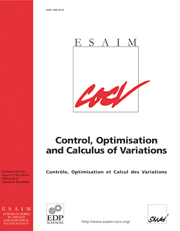Crossref Citations
This article has been cited by the following publications. This list is generated based on data provided by
Crossref.
Giorgio, Ivan
Della Corte, Alessandro
dell'Isola, Francesco
and
Steigmann, David J.
2016.
Buckling modes in pantographic lattices
.
Comptes Rendus. Mécanique,
Vol. 344,
Issue. 7,
p.
487.
Mielke, Alexander
and
Roubíček, Tomáš
2016.
Rate-independent elastoplasticity at finite strains and its numerical approximation.
Mathematical Models and Methods in Applied Sciences,
Vol. 26,
Issue. 12,
p.
2203.
Benešová, Barbora
and
Kružík, Martin
2017.
Weak Lower Semicontinuity of Integral Functionals and Applications.
SIAM Review,
Vol. 59,
Issue. 4,
p.
703.
Palmer, Aaron Z.
and
Healey, Timothy J.
2017.
Injectivity and self-contact in second-gradient nonlinear elasticity.
Calculus of Variations and Partial Differential Equations,
Vol. 56,
Issue. 4,
Eremeyev, Victor A.
dell’Isola, Francesco
Boutin, Claude
and
Steigmann, David
2018.
Linear Pantographic Sheets: Existence and Uniqueness of Weak Solutions.
Journal of Elasticity,
Vol. 132,
Issue. 2,
p.
175.
Eremeyev, Victor A.
and
dell’Isola, Francesco
2018.
Generalized Models and Non-classical Approaches in Complex Materials 1.
Vol. 89,
Issue. ,
p.
301.
Friedrich, Manuel
and
Kružík, Martin
2018.
On the Passage from Nonlinear to Linearized Viscoelasticity.
SIAM Journal on Mathematical Analysis,
Vol. 50,
Issue. 4,
p.
4426.
Roubíček, Tomáš
and
Stefanelli, Ulisse
2018.
Thermodynamics of Elastoplastic Porous Rocks at Large Strains Towards Earthquake Modeling.
SIAM Journal on Applied Mathematics,
Vol. 78,
Issue. 5,
p.
2597.
Benešová, Barbora
Kružík, Martin
and
Schlömerkemper, Anja
2018.
A note on locking materials and gradient polyconvexity.
Mathematical Models and Methods in Applied Sciences,
Vol. 28,
Issue. 12,
p.
2367.
Roubíček, Tomáš
and
Tomassetti, Giuseppe
2018.
A thermodynamically consistent model of magneto-elastic materials under diffusion at large strains and its analysis.
Zeitschrift für angewandte Mathematik und Physik,
Vol. 69,
Issue. 3,
Mielke, Alexander
Rossi, Riccarda
and
Savaré, Giuseppe
2018.
Global Existence Results for Viscoplasticity at Finite Strain.
Archive for Rational Mechanics and Analysis,
Vol. 227,
Issue. 1,
p.
423.
Roubíček, Tomáš
and
Stefanelli, Ulisse
2019.
Finite thermoelastoplasticity and creep under small elastic strains.
Mathematics and Mechanics of Solids,
Vol. 24,
Issue. 4,
p.
1161.
Palmer, Aaron Zeff
2019.
Variations of Deformations with Self-Contact on Lipschitz Domains.
Set-Valued and Variational Analysis,
Vol. 27,
Issue. 3,
p.
807.
Krömer, Stefan
and
Valdman, Jan
2019.
Global injectivity in second-gradient nonlinear elasticity and its approximation with penalty terms.
Mathematics and Mechanics of Solids,
Vol. 24,
Issue. 11,
p.
3644.
Krömer, Stefan
and
Roubíček, Tomáš
2020.
Quasistatic Viscoelasticity with Self-Contact at Large Strains.
Journal of Elasticity,
Vol. 142,
Issue. 2,
p.
433.
Friedrich, Manuel
and
Kružík, Martin
2020.
Derivation of von Kármán Plate Theory in the Framework of Three-Dimensional Viscoelasticity.
Archive for Rational Mechanics and Analysis,
Vol. 238,
Issue. 1,
p.
489.
Eremeyev, V. A.
and
dell’Isola, F.
2020.
Weak Solutions within the Gradient-Incomplete Strain-Gradient Elasticity.
Lobachevskii Journal of Mathematics,
Vol. 41,
Issue. 10,
p.
1992.
Mielke, Alexander
and
Roubíček, Tomáš
2020.
Thermoviscoelasticity in Kelvin–Voigt Rheology at Large Strains.
Archive for Rational Mechanics and Analysis,
Vol. 238,
Issue. 1,
p.
1.
Davoli, Elisa
Kružík, Martin
Piovano, Paolo
and
Stefanelli, Ulisse
2021.
Magnetoelastic thin films at large strains.
Continuum Mechanics and Thermodynamics,
Vol. 33,
Issue. 2,
p.
327.
Melching, David
Neunteufel, Michael
Schöberl, Joachim
and
Stefanelli, Ulisse
2021.
A finite-strain model for incomplete damage in elastoplastic materials.
Computer Methods in Applied Mechanics and Engineering,
Vol. 374,
Issue. ,
p.
113571.


